TerraMaster F2-422 2-Bay 10GbE NAS Specifications
Here are the key specs from the F2-422:
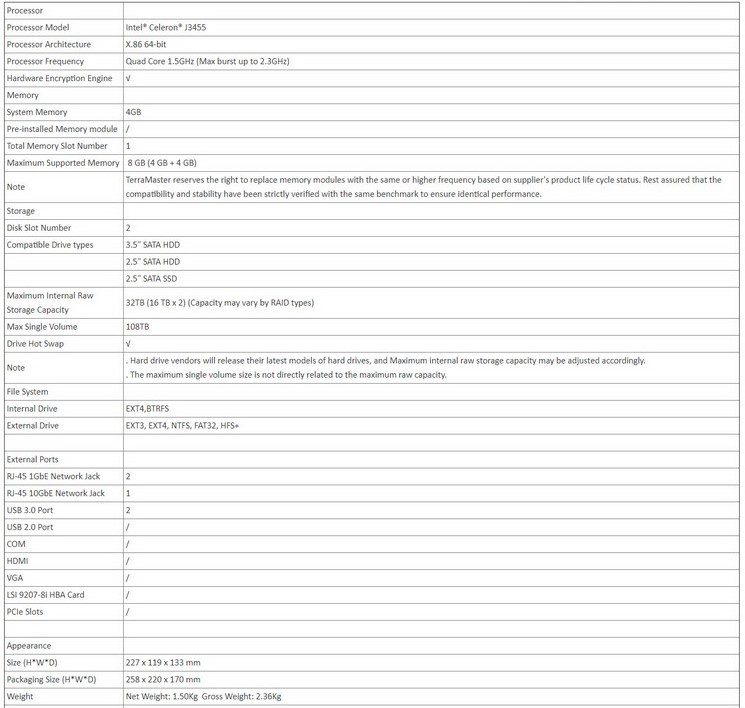
The processor used in the F2-422 is the Celeron J3455 quad-core that has a base speed of 1.5 GHz and can Turbo up to 2.3 GHz. The network chip used is a very popular Marvell/ Aquantia AQC-107 10Gbase-T controller which can also operate at 1GbE, 2.5GbE, and 5GbE speeds.
The platform that we use for the testing on all of our NAS consists of the following items:
- Test system configuration
- Motherboard: ASUS ROG Zenith II Extreme Motherboard
- CPU: AMD Threadripper 3960X (24 core / 48 Threads)
- GPU: NVIDIA RTX 2080 SUPER
- Cooling: NZXT Kraken X62
- RAM: Corsair Dominator Platinum RGB 3600MHz 4x 16GB DDR4 (64GB Total)
- SSD: Sabrent Rocket 1TB NVMe Gen 4 SSD
- OS: Windows 10 Pro
- TerraMaster F2-422 2-Bay 10GbE NAS Storage: 2x Seagate Ironwolf 4TB HDD’s.
Let us continue with testing the TerraMaster F2-422 2-Bay 10GbE NAS.
TerraMaster F2-422 Performance
We are going to run this unit through our standard tests to see how it performs.
Intel NAS Performance Toolkit
The Intel NAS Performance Toolkit (Intel NASPT) is a file system exerciser and analysis tool designed to enable performance comparisons between network-attached storage (NAS) devices.
Our previous tests shown in our graphs were from NAS units that offered more than two HDD’s of storage. With these, we used RAID 6. The F2-422 2-Bay 10GbE is our first 2-Bay 10GbE NAS we have tested, so our graphs would have had only one set of results. Instead, we wanted to show how a 2-Bay 10GbE NAS might compare to other higher-end NAS’s that offer more drive bays.
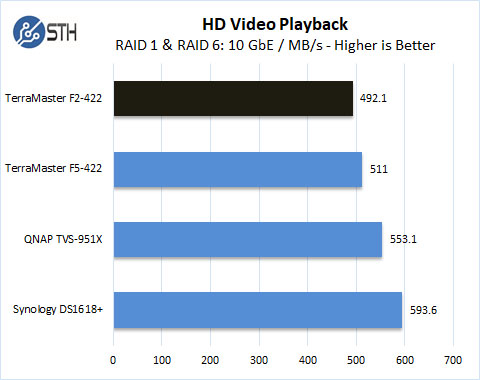
Our F2-422 2-Bay 10GbE NAS comes close to the performance we see on the F5-422 5-Bay NAS with more drives. We do start to see a performance increase when more HDD’s are added to the pool. Also, consider that the F2-422 2_bay NAS runs in RAID 1 vs. the other NAS units are running in RAID 6.
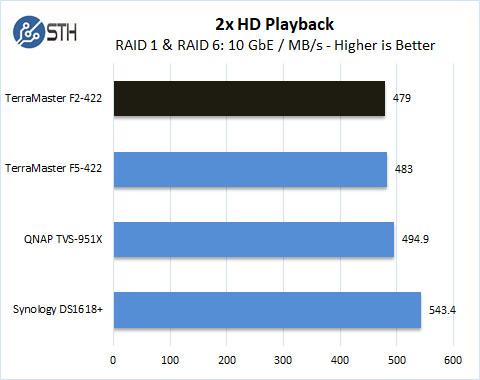
Again, we see that the other NAS’s with larger HDD pools running in RAID 6 outperforms the 2-Bay running in RAID 1. However, it does keep up pretty well; this is a trend we will continue to see in later tests.
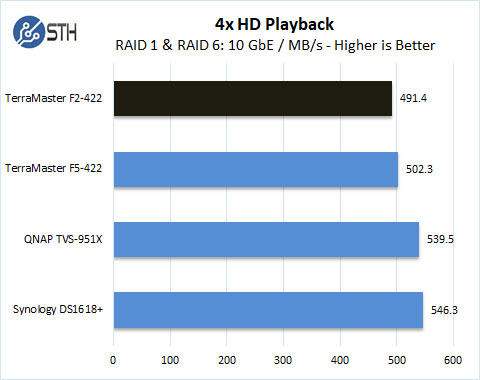
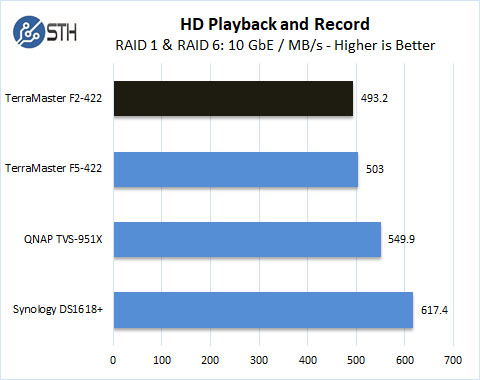
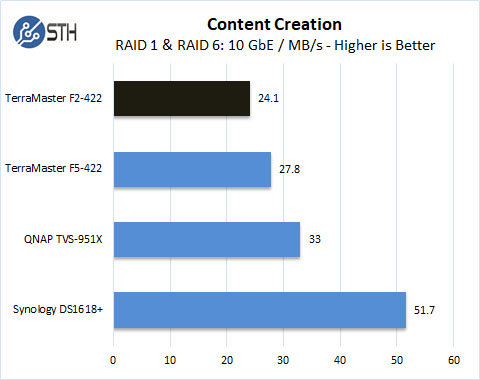
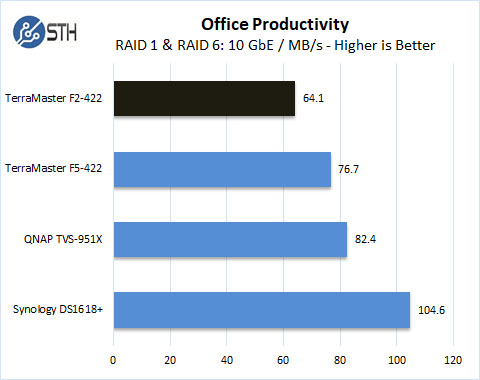
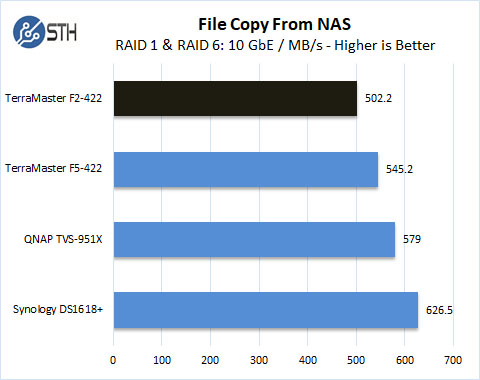
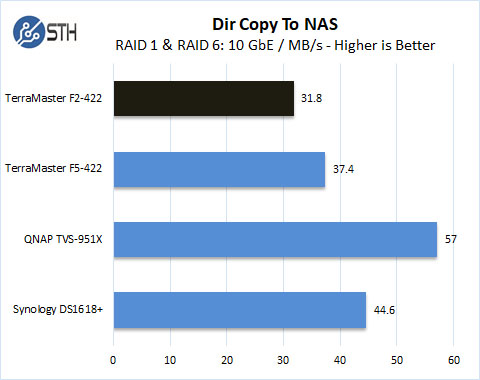
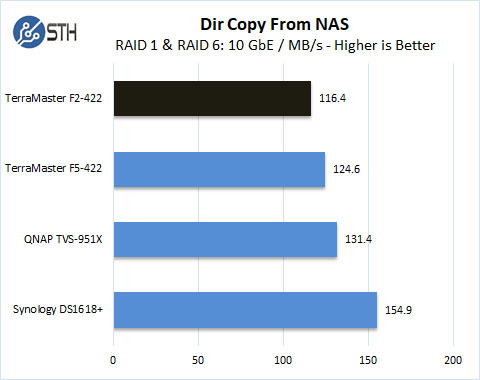
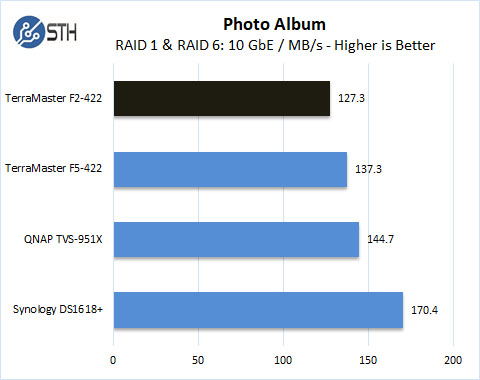
In these tests, we see the TerraMaster F2-422 2-Bay 10GbE NAS compared to considerably higher-end NAS boxes with additional storage bays. It is not surprising to show up at the bottom of the performance numbers. However, the cost of entry in the 10GbE area is much lower with F2-422 2-Bay 10GbE NAS and still maintain reasonable performance levels above 1GbE networks. Larger pools of HDD’s in RAID 6 also perform better in our tests.
Let us finish up with our final thoughts.
Final Words
The F2-422 2-bay 10GbE NAS is very intriguing. One on hand, it is a 2-bay NAS which is a relatively inexpensive segment (Amazon Affiliate Link.) There are many units which cost significantly less in the 2-bay NAS segment, but those units tend to use ultra low power and performance Arm CPUs as well as multiple network ports, and 10GbE.
On the other end, moving to a 4-bay NAS is about $140 more and a 5-bay is $240 more. That gives us, on a cost/ drive basis:
- F2-422 2-bay: $180/ drive
- F4-422 4-bay: $125/ drive
- F5-422 5-bay: $120/ drive
With the larger NAS units we get more expandability along with more performance due to the additional spinning disks. As a result, we see the market for a NAS like this really for those who need some network storage, but not necessarily a highly expandable array. As an example, if you have a legal office where you are storing mostly documents, PC backups, and audio recordings, then a NAS like this can make a lot of sense. If you, however, are running a small photography/ video business, then the 4-bay or 5-bay options are probably better options even if you are not using that capacity at the outset.
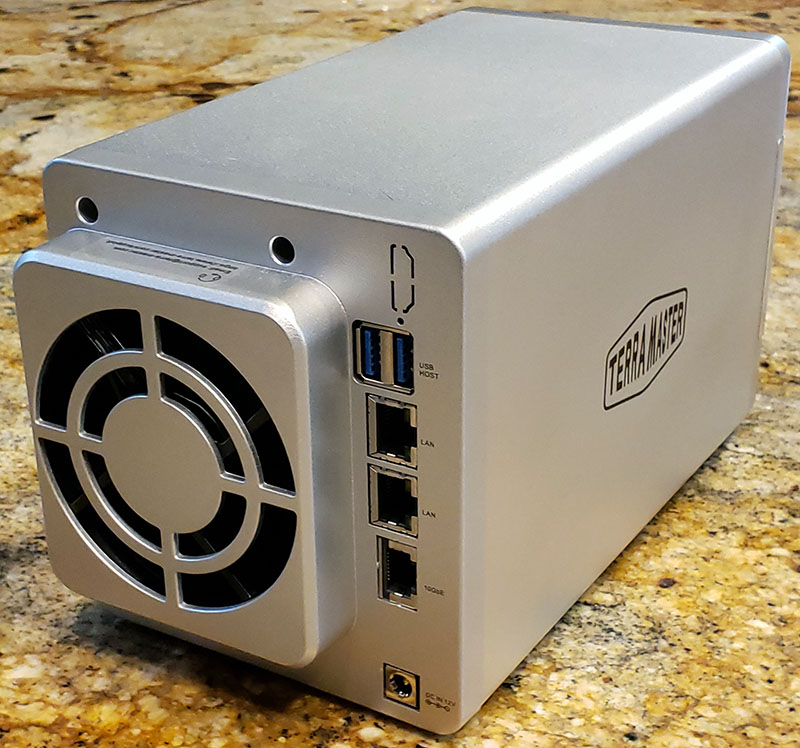
Something we really like with this unit is the 10GbE networking. Many of the 1GbE-only NAS units in the 2-bay space have more disk performance than they have network performance. With WiFi 6, we are going to see a transition to 2.5GbE for client devices, SMB/ SOHO switches, and faster than 1Gbps wireless networks. At some level, it makes sense to get a NAS that scales beyond 1GbE today as client devices will have faster than 1Gbps networking in 2021 and beyond. At the same time, for many who just need document backup and sharing, a F2-221 2-Bay 1GbE NAS is $100 less expensive. For many, that $100 is the primary deciding factor in which NAS to purchase. The trade-off is less future-proofing for performance (assuming speeds beyond 1Gbps matter.)
Overall the F2-422 2-bay NAS has unique features like 10Gbase-T networking that make it stand out in the space. There is a premium associated with the unit, and many of our readers may opt for the larger NAS siblings instead for additional expansion. At this end of the market, there is hyper-segmentation so TerraMaster and other NAS vendors are trying to hit specific price/ feature points. The unique point the F2-422 hits is intriguing with a 2-bay NAS and 10Gbase-T.




nice article, but the performance numbers don’t make sense.
over 400MB/s sequential would make sense if they were in RAID 0, but in RAID 1 it seems like you’d have more like < 200MB/s?
The speeds shown here are completely unrealistic, the only way you’d conceivable achieve that is with more drives or an SSD cache..
That brings me onto my next point, 10GbE makes zero sense on a box with only 2 Bays..
The only budget NAS I’m aware of that can deliver performance that justifies a 10GbE is the QNAP TS-332X.
@Kelv1n you must not be familiar with the newest sata HDD models which can deliver 270+ MB/s sequential. That’s enough to saturate 2.5Gbe. Two of them in raid 0 will saturate 5Gbe. Ergo, 10Gbe is the minimum required for a 2 bay NAS in 2020 to avoid potential bottlenecks.
@Mark many modern raid 1 implementations are actually a 2 drive raid 10. This allows reads to be interleaved, performing like a raid 0 on reads. Not sure if that is the case here, but the 400+ mb/s shown suggests so.
@Mark/@George: Raid1 parallel read is trivial (just read the odd blocks from drive 1 and the even blocks from drive 2). Could be more fancy by measuring the IO queue and using the shortest one, but in essence this is the same.
@George what drives are you referring to? SMR?
@George please treat HDD manufacturer spec sheets with a healthy measure of scepticism.
I’ve got a couple of NAS boxes that I tinker with (had 4 til the wife made me sell 2), my main one is a well spec’d TVS-1282 with 8x6TB Seagate Ironwolf HDDs. You’re correct that individually they benchmark fairly high, 230MB/s in this case, which given your statement, should give 1800MB/s+ throughput, right?
Not quite, the aggregate performance is always substantially less them the individuals totalled. There are a lot of factors that play into NAS performance including Network latency, drive latency, software RAID (All consumer NAS’s use this), CPU, RAM and the underlying filesystem. Real-world with sequential read 8 drives give around 700-800MB/s on a 10Gb/s network (with jumbo frames), to get to saturation point, requires more drives or a cache (SSD, NVMe or RAM), personally I have 4x 1TB SSD’s installed.
Given this, even being generous (given the age of the CPU and RAM) the most you will see from this box in 200MB/s at burst, ergo 10GbE is WASTED.. A side note, If you care to read the TerraMaster website, it shows the max performance of this NAS is 651MB/s that is using 2x ** 4TB SSD’s **
Whilst I normally respect the opinions of folks at STH and TerraMaster usually deliver good value, this box does not rate this score. Its sold as supporting RAID and SSD caching, but fact is, its only 1 or the other… The score should be calculated from performance, hardware features and value for money, you say 10GbE should the minimum, I agree, but likewise so should the requirement for at least 1 M.2 DATA SSD or NVMe slot.
I point back too the QNAP TS-332X, which is available for around the same price point, with 10GbE and has 3x HDD bays and 3x M.2 slots, its not perfect (ARM CPU) but its better value and far better performance than this.
This thing won’t stay connected it’s fail don’t buy
@Kelv1n, what would you use in place of 10 Gbe on this device? 2.5/5 are not well established yet. Would you use 1Gbe and cut your predicted 200 MB/s in half? Why bottleneck the device with 1Gbe when you know it’s capable of much more? Clearly the designers came to this same conclusion. FYI most 10Gbe interfaces will fall back to 1Gbe, so you can safely use this on your 1Gbe network without worry over “wasting” a 10Gbe link.
As for actual drive performance vs. spec sheets, I can only speak to my own setup, a pair of 16 TB WD Gold drives, which delivers an honest 500 MB/s in sequential reads in a 2-drive RAID-10 mirror using mdadm on CentOS 8.
@George, use LACP or multipathing on the 2x 1Gb/s ports (both SMBv3.x and NFSv4.x now support multi-pathing/multi-channel), but my argument is not about it having a 10Gb port itself, its the rest of the hardware (or lack of), such as
1) Its using 5 year old CPU
2) It uses DDR3 RAM
3) There is no M.2 or NVMe slots
Which makes a 10GbE NIC superflous. Not only does the reviewer fail to point out these gaps, he goes on to rate it 8.8, praising it as the latest and greatest, rather holding the vendor to account and pointing out the flaws and the fact this is outdated junk.
So to my point – There are far more capable NAS’s that take DDR4 and have M.2/NVMe slots with 10GbE NICs, so you’ll get 3-4x the storage performance for around the same price bracket.